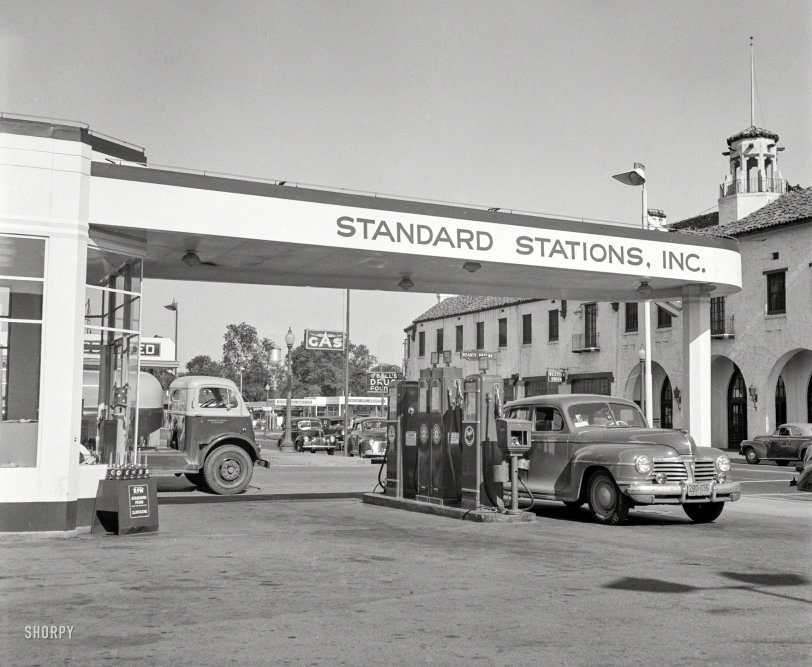


Framed or unframed, desk size to sofa size, printed by us in Arizona and Alabama since 2007. Explore now.
Shorpy is funded by you. Patreon contributors get an ad-free experience.
Learn more.

- Freeze Frame
- Texas Flyer wanted
- Just a Year Too Soon
- WWII -- Replacing men with women at the railroad crossing.
- Yes, Icing
- You kids drive me nuts!
- NOT An Easy Job
- I wonder
- Just add window boxes
- Icing Platform?
- Indiana Harbor Belt abides
- Freezing haze
- Corrections (for those who care)
- C&NW at Nelson
- Fallen Flags
- A dangerous job made worse
- Water Stop
- Passenger trains have right of way over freights?
- Coal
- Never ceases to amaze me.
- Still chuggin' (in model form)
- Great shot
- Westerly Breeze
- For the men, a trapeze
- Tickled
- Sense of loneliness ...
- 2 cents
- Charm City
- What an Outrage
- Brighton Park
Print Emporium
Standardized: 1942

June 1942. "Tracy, California. Gasoline filling station." With a Beauty Parlor for major overhauls. Photo by Russell Lee, Office of War Information. View full size.
Those oil bottles -
My best friend's dad owned and drove taxicabs in New York City as we were growing up in the late 50s and early 60s. I imagine that in an effort to be frugal, he would drain the oil and then filter it through cheesecloth or something similar, and then rebottle it for the next cycle. At least it filtered out the "big" stuff though it did not take care of oil that may have oxidized. He also had those wire carriers that held six bottles.
Summer of '62
I was a pump jockey that year, and pumped gas for 16 cents a gallon during a price war in OKC.
The Tracy Inn
This photo was taken across West 11th Street, facing the Tracy Inn (constructed in 1927, and still in place). It was near the intersection of U.S. Highways 50 (once part of the 1915 Lincoln Highway, now I-205 Business) and 99A, and the West Side Highway (now State Route 33 north). The Standard Station itself has been replaced by a mixed-use building that houses, among other things, the Tracy Press. With most highway traffic now diverted around downtown Tracy, the number of service stations at this intersection has gone from three to zero.
[Riding through downtown Tracy is a memory of just about every Bay Area kid of my generation and before whose family vacationed in Yosemite. -tterrace]
Gas rationing?
I was 8 years old when this picture was taken. Seeing no gas rationing stickers on the windows of the cars, I found this information:
"By the end of 1942, half of U.S automobiles were issued an 'A' sticker which allowed 4 gallons of fuel per week."
Brand loyalty
There was brand loyalty back in those days, too. I don't think price was the only criterion. The oil companies were early users of account cards, which is all you needed to fill the tank. My Dad had a Union Oil Company of California card and always sought out Union stations and their associates from 1946 to the late 1960s. I had a Mobilgas card, which also covered various kinds Standard Oil stations elsewhere in the country. Good for repairs, tires and batteries as well. You got a monthly bill in the mail, which you paid in full like an American Express Green card.
Detroit Gas Wars
I had a 1967 VW beetle which I purchased new in 1967. For years I never spent more than $3.00 to fill its 10 gallon tank. The lowest gas prices I remember was 18.9 cents per gallon for Gulftane in the Detroit area.
Oil Bottles
I don't miss the glass oil bottles, but sure miss the long spouts. It would really be nice today when oil fills are hidden by hoses, wires, and covers.
As in the previous shot
Love those old cab-overs.
Another View
Of yesterday's photo. The tanker that appears to be leaving was filling up the gasoline in-ground tanks.
Gassy part of town
Three gas station on three corners. I wish they would post the prices like they do today. It would be interesting seeing what they charged back then. I remember gas wars and prices of $.30 per gallon during my youth.
























On Shorpy:
Today’s Top 5